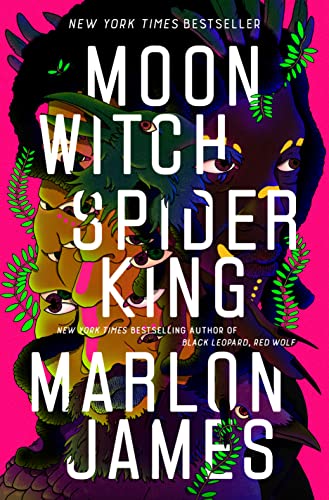
Marlon James’ Moon Witch Spider King (second book of the Dark Star trilogy) impressed me at first as everything I had missed in the first novel, Black Leopard Red Wolf. There was a story of emotional depth I could link into and a brilliant character I could care about, as opposed to the strangely alienating violence and confusing action of the earlier book. The first book, told from the point of view of Tracker, a hunter with the nose of a wolf that never loses a trail, detailed a quest for a lost boy. But the identity of the boy hardly matters in that first book, and the search breaks up into a series of adventures with supernatural beings, lots of violence and sex that always kept me at a distance.
But that may have been the point. Gautam Bhatia’s excellent review of Black Leopard Red Wolf helpfully illuminates the author’s purpose in challenging the fantasy trope of the quest, partly through the use of Brechtian techniques designed to keep the reader away from simple emotional identification with characters in order to focus on larger issues. Reading Moon Witch Spider King makes me want to go back to the first book. For this second novel is rich in characters and ideas I can relate to about power, memory, identity and love while also critiquing the standard form of western fantasy. This novel unfolds through the long life story of Sogolon, who ultimately joins the Tracker’s search but with far different motives and little use for Tracker’s antics. I’ll sketch out the bare elements of the story to bring out some of its key themes, so there are spoilers in what follows.
Most of Moon Witch Spider King takes place hundreds of years before the action of the first novel and starts with Sogolon’s brutal childhood. Scorned at birth as a girl in a family of boys, she is especially despised because her mother died in giving birth. Her brothers regard her as mother-killer, and that death drove their father to madness and early death as well. So as a girl, never given a name, she lives in a termite mound and barely survives.
But survive she does, discovering early on a special power within her, which she calls wind (no wind), an explosive force that emerges from her without her conscious control when she is threatened with violence or death. Despite that power, this girl is always seen by those around her as powerless. After she manages to escape from her childhood home in the termite mound, she is given a job in Miss Azora’s whorehouse in the city of Kongor where she is called by the name of her mother, Sogolon.
Then she is taken out of that house by the noblewoman Mistress Komwono. As the master of the Komwono household is lecturing her on how powerless she is and then attempts to rape her, the wind (no wind) throws him to the ceiling where he is impaled on a beam. That sets a pattern of her being reminded by those who try to control her that she is a worthless nobody, only to experience that explosive force within her. Yet most of the time, no one associates such violent events with this slim no-account girl.
The Mistress Komwono, attempting to curry favor with the king’s sister, Emini, in the royal city of Fasisi, gives Sogolon to her as a slave. The line of kings is supposed to go through the sons of the king’s sister, but Emini can’t have children with her husband. When Emini is discovered taking lovers to try to have a son, she is banished and takes Sogolon with her. But the entire party is attacked by the demon minions of the frightening royal counsellor Aesi. They are all killed except for Sogolon whose power destroys the demons in a huge explosion that leaves her buried at the bottom of a great crater. She claws her way out of this grave in a great scene of re-birth.
She is taken back to Fasisi by the royal guard Keme, who turns out to be a lion shapeshifter. The bond between Sogolon and Keme becomes an emotional highpoint of the story, and the scenes of caustic repartee between them I find completely charming. She stays with him for five years, bearing several children, including young lions, but this does not bring her peace. Sogolon is so full of rage and a need for vengeance with no clear object that she disguises herself as a man and goes out at night to a deadly fighting arena to beat and sometimes kill opponents who mean nothing to her.
The counsellor Aesi becomes the focus of her need for vengeance after he kills one of her lion sons. But he is a nearly immortal figure with godlike powers. One of his powers – to cause people to forget the past – highlights a major theme of the story, that of forgetting and the link between memory and identity. But he is unable to penetrate Sogolon’s mind to take her memories away. The griots of this world preserve memories but are in disfavor, since they are thought to be in league with witches, and are stoned and driven out whenever they start singing or story-telling to recall the forgotten past.
After the death of her child, Sogolon retreats in her grief to live alone in the forest, where she goes about her own work of forgetting, as she puts it, by drugging herself into long bouts of sleep and remaining in complete isolation from human contact. All this happens by the time she is twenty-two.
The story jumps ahead about 150 years. During that long time, Sogolon is called out of her state of aloneness when people, thinking of her as a witch, ask her to help them find vengeance, usually against brutal men who have betrayed women. She keeps trying to retreat to living alone, the one state she has actually chosen, and rejects the title of Moon Witch that others bestow on her. But one day all that changes, and the story begins to link up to the search for the lost boy that dominated the action in Black Leopard Red Wolf.
She meets three beings. These are the water spirit, Popele; her own great-great granddaughter, Nsaka Ne Vampi, who has powers of her own; and an old griot named Ikeda. By this time, Sogolon has forgotten much of her life and has to bring it back to memory by reading the stories written down by the griot. As Ikeda puts it, “Paper is where I find you. And where you going to find yourself.” (p383) At a stroke, Marlon James raises several questions. Whose story is this? How much is true, how much is legend? Can Sogolon find herself in what is written about her and told to her or is she going to find only another identity that others have imposed on her? There is no easy answer.
Ikeda and Popele tell her stories that awaken her memory about Aesi and the fact that she had killed him before and how is reborn as a young boy eight years after death. He lives as a boy until he is twelve when he undergoes the rites that turn him into a man. He can only permanently die if he is caught after he is a boy but before the ritual of manhood is complete. Death at that point can break the cycle. So that becomes her task but possibly a never ending one since Sogolon may have to kill Aesi over and over again.
Late in the novel, Sogolon and her group join up with Tracker in pursuit of the lost boy, who turns out to be the true heir to the kingdom. But Sogolon has little use for kings and institutions of power. She is continually struggling against the tasks others pull her into and the ways they define her yet always questions how she can define herself and what she lives for.
Moon Witch Spider King is a complex, absorbing book that rewards re-reading. Along with Black Leopard Red Wolf, it challenges all the conventional ideas about fantasy while raising profound questions about memory and identity. Its rich language brings to life a wildly imaginative assortment of characters, both human and supernatural. Taken as a whole, this is a great work in progress, and like many truly original books, can seem awkward at first because it refuses to meet conventional expectations of what fantasy should be and how a story should be told. But stay with it. Dark Star is a richly rewarding series.




Leave a Reply